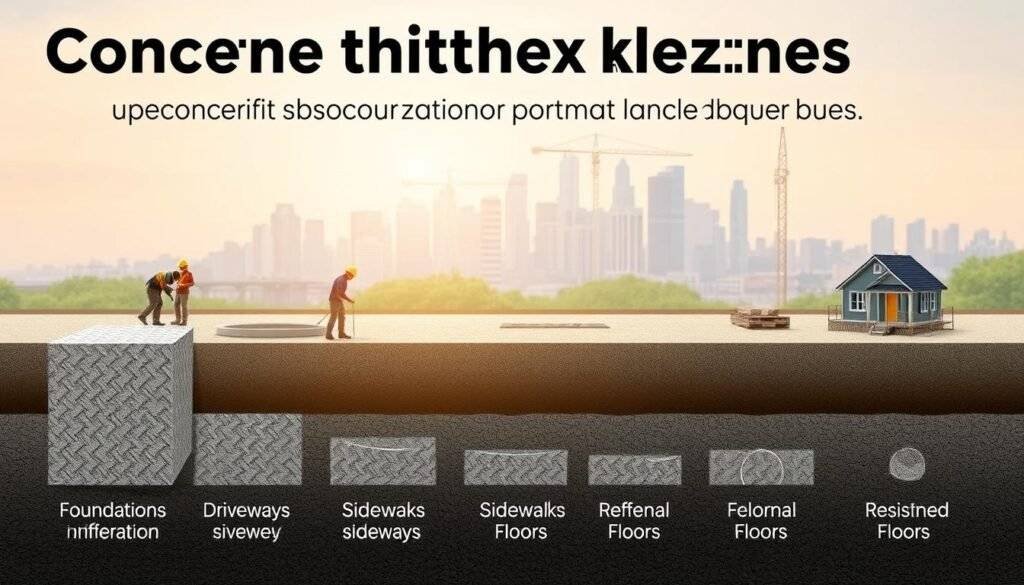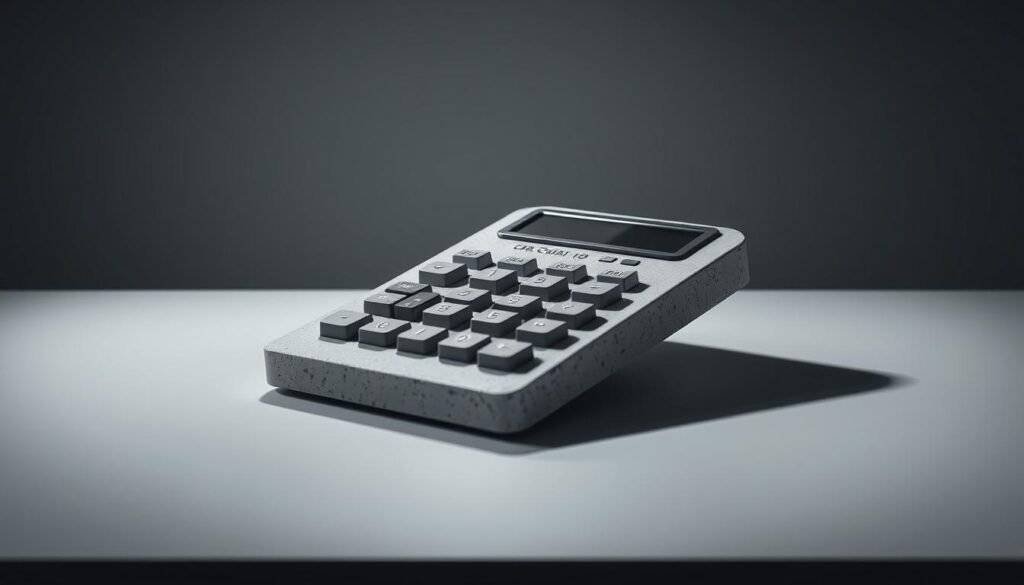When undertaking a construction project, it’s crucial to accurately determine the amount of concrete needed to avoid costly mistakes and unnecessary delays.
Our calculator is designed to simplify this process, helping you estimate the volume of concrete required in cubic yards or bags, tailored to your specific project dimensions.
By using our concrete calculator, you can ensure that you’re not over-ordering or coming up short, saving both time and money.
Understanding how to calculate much concrete you need is essential for both DIY enthusiasts and professional contractors to ensure project success.
Key Takeaways
- Accurately estimate the amount of concrete needed for your construction projects.
- Use our calculator to determine the precise volume of concrete required.
- Avoid costly mistakes by ensuring you have the right amount of concrete.
- Customize calculations based on your specific project measurements.
- Save time and money by preventing over-ordering or coming up short.
Understanding Concrete Calculations
Accurate concrete calculations are the backbone of any successful construction project. To ensure that your project is completed on time and within budget, you need to understand how to calculate the volume of concrete required.
Why Accurate Concrete Estimation Matters
Accurate concrete estimation is crucial to avoid running short during a pour, which can create cold joints and structural weaknesses, or over-ordering and wasting money on excess material. Using a concrete calculator or a simple volume formula can help you get it right.
Basic Concrete Measurement Principles
To calculate the volume of concrete needed, you use the formula: Length × Width × Thickness. Measure your project and multiply the dimensions to get cubic feet or meters. For instance, if you’re working on a slab, you’ll need to calculate its area in square feet and then determine the thickness to find the volume in cubic feet. To convert cubic feet to cubic yards, divide by 27.
| Measurement Unit | Conversion Factor |
|---|---|
| Cubic Feet to Cubic Yards | Divide by 27 |
| Square Feet | Length × Width |
The Magic Number: 81 Square Feet
The “magic number” 81 provides a quick way to estimate concrete needs for standard 4-inch slabs. Simply divide your total square footage by 81 to get the number of cubic yards you need. For example, for a 200 square feet area, you would need 200 ÷ 81 = 2.46 cubic yards of concrete for a 4-inch slab.
By understanding these basic principles and using the right tools, such as a concrete calculator, you can ensure that your project is well-planned and executed efficiently.
How to Use Our Concrete Calculator

Our concrete calculator is designed to simplify the process of estimating the concrete required for various projects. With a user-friendly interface, you can easily input your project dimensions and receive accurate concrete volume calculations.
Step-by-Step Guide to Measuring Your Project
To ensure accurate calculations, it’s essential to measure your project correctly. Here are the steps to follow:
Measuring Length, Width, and Thickness
Measure the length, width, and thickness of your project in consistent units, either feet or inches. For most projects, measuring in feet is more convenient.
Handling Irregular Shapes
For irregular shapes, break down the area into multiple regular shapes, calculate the concrete volume for each, and then sum the results for an accurate estimation.
Calculating Different Project Types
Our concrete calculator can handle various project types, including slabs, footings, columns, and stairs. Here’s how to calculate concrete for different projects:
Slabs and Footings
For rectangular slabs and footings, simply input the length, width, and thickness to get the concrete volume.
Columns and Circular Projects
For circular columns and footings, enter the diameter and height to calculate the concrete volume.
Stairs and Curbs
For stairs and curbs, break down the structure into simpler shapes and calculate the concrete volume for each part.
Understanding the Results
Once you’ve input your project dimensions, our calculator will provide the estimated concrete volume in cubic yards or the number of bags required. You can then decide whether to purchase ready-mix concrete or bags, depending on your project’s needs.
Common Concrete Projects and Calculations
The key to a successful concrete project lies in understanding the specific requirements for different applications. Different projects demand different thickness and volumes of concrete, making accurate calculations crucial.
Standard Concrete Thicknesses for Different Applications
The thickness of concrete varies significantly depending on its intended use. For residential projects, the standard thickness is typically considered.
Residential Slabs
For residential slabs, such as patios and walkways, a standard slab thickness of 4 inches is commonly used.
Driveways and Garage Floors
Driveways and garage floors often require a thicker slab, typically 5-6 inches, to support heavier loads.
Commercial Applications
Commercial applications may necessitate even thicker concrete, often 6-8 inches or more, due to the high traffic and heavy loads they endure.

Calculating Concrete for Specific Projects
Calculating the right amount of concrete is critical for the success of a project. Let’s consider a few common projects.
10×10 Slab Calculations
For a 10×10 slab with a 4-inch thickness, you’ll need approximately 1.24 cubic yards of concrete, which translates to about 56 80-pound bags.
Driveway Calculations
A typical driveway requires more concrete due to its larger size and often thicker slab. For instance, a 6-inch thick driveway will need more cubic yards of concrete compared to a 4-inch thick slab.
Steps and Stairs Calculations
For steps and stairs, the calculation involves not just the surface area but also the volume of each step, requiring a detailed approach to determine the exact amount of concrete needed.
Bags vs. Ready-Mix: Making the Right Choice
When it comes to procuring concrete, you can choose between bags of pre-mixed concrete and ready-mix concrete delivered to your site.
Converting Cubic Yards to Bags
To convert cubic yards to bags, remember that an 80-pound bag yields about 0.022 cubic yards of concrete. So, for a project requiring 1 cubic yard of concrete, you’ll need about 45.45 bags (1 / 0.022).
When to Choose Each Option
Ready-mix concrete is often more economical and practical for larger projects, while bags of concrete are better suited for smaller projects or those with limited access to mixer trucks.
Conclusion: Ensuring Successful Concrete Projects
As we conclude our guide on using a concrete calculator, it’s essential to remember that accurate calculations are just the beginning of a successful project. To ensure your concrete project meets structural requirements and aesthetic expectations, proper site preparation is crucial.
When ordering concrete, it’s vital to include a margin of safety to account for spillage, uneven ground, and slight measurement errors. We recommend ordering 5-10% extra concrete than your calculator indicates. This extra amount will help prevent delays and ensure your project stays on track.
Additionally, when budgeting for materials, consider adding 1/4″ to the thickness of your slab as a safety margin. This assumes you have the job evenly graded to the right depth, and the grade is well compacted. Proper site preparation, including accurate grading and compaction, works hand-in-hand with precise cubic yard calculations to ensure your concrete project is successful.
For complex projects, consider consulting with professional contractors who can provide expertise on mix designs, reinforcement requirements, and finishing techniques beyond basic volume calculations. By combining accurate calculations with proper planning and execution, you’ll be well on your way to a successful concrete project that meets your needs and exceeds your expectations.
FAQ
How do I determine the thickness of my slab?
The thickness depends on the project’s purpose. For instance, a typical residential slab is 4 inches thick, while a driveway or heavy-load slab may require 6 inches or more.
What is the difference between bags of mix and ready-mix concrete?
Bags of mix are pre-mixed concrete that you mix on-site, ideal for smaller projects. Ready-mix is delivered in bulk, suitable for larger projects, and often more cost-effective.
How do I calculate the volume of concrete needed for my project?
To calculate the volume, multiply the length, width, and depth of your project in feet, then convert the result to cubic yards by dividing by 27.
What is the standard size of a cubic yard?
A cubic yard is a unit of volume, equivalent to 27 cubic feet. It’s a standard measurement for ordering ready-mix.
How much waste should I account for in my concrete order?
It’s recommended to add 5-10% to your total volume to account for waste, spills, and uneven surfaces.
Can I use our concrete volume to determine the cost?
Yes, once you know the volume, you can estimate the cost by multiplying it by the price per cubic yard of ready-mix or the cost of bags.
How do I measure the surface area of an irregularly shaped project?
Break down the area into simpler shapes, calculate the area of each, and sum them up to get the total surface area.

